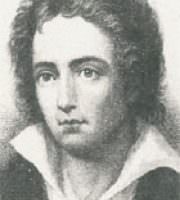by Percy Bysshe Shelley
I met a traveller from an antique land
Who said: "Two vast and trunkless legs of stone
Stand in the desert . . . Near them, on the sand,
Half sunk, a shattered visage lies, whose frown,
And wrinkled lip, and sneer of cold command,
Tell that its sculptor well those passions read
Which yet survive, stamped on these lifeless things,
The hand that mocked them, and the heart that fed:
And on the pedestal these words appear:
'My name is Ozymandias, king of kings:
Look on my works, ye Mighty, and despair!'
Nothing beside remains. Round the decay
Of that colossal wreck, boundless and bare
The lone and level sands stretch far away."
Last updated July 08, 2015
Ozymandias is a sonnet written by the English romantic poet Percy Bysshe Shelley. First published in the 11 January 1818 issue of The Examiner in London, it was included the following year in Shelley's collection Rosalind and Helen, A Modern Eclogue; with Other Poems (1819) and in a posthumous compilation of his poems published in 1826. "Ozymandias" is regarded as one of Shelley's most famous works and is frequently anthologised. In antiquity, Ozymandias was an alternative name for the Egyptian pharaoh Ramesses II. Shelley began writing his poem in 1817, soon after the announcement of the British Museum's acquisition of a large fragment of a statue of Ramesses II from the thirteenth-century BC, and some scholars believe that Shelley was inspired by this. The 7.25-ton fragment of the statue's head and torso had been removed in 1816 from the mortuary temple of Ramesses at Thebes by the Italian adventurer Giovanni Battista Belzoni (1778–1823). It was expected to arrive in London in 1818, but did not arrive until 1821. Shelley wrote the poem in friendly competition with his friend and fellow poet Horace Smith (1779–1849) who also wrote a sonnet on the same topic with the very same title. Smith's poem would be first published in The Examiner a few weeks after Shelley's sonnet. Both poems explore the fate of history and the ravages of time—that all prominent figures and the empires they build are impermanent and their legacies fated to decay and oblivion. more about the poem can be read on Wikipedia




